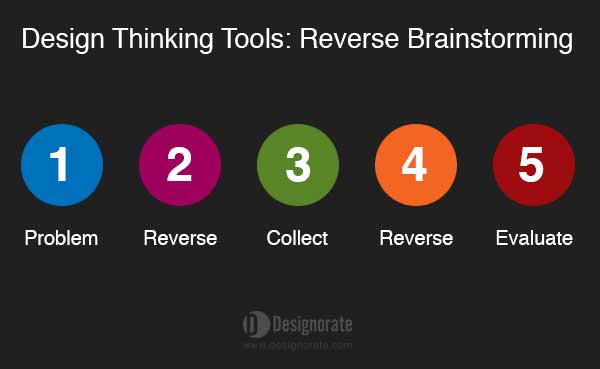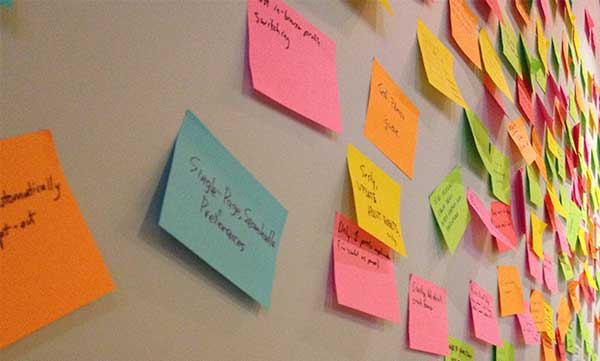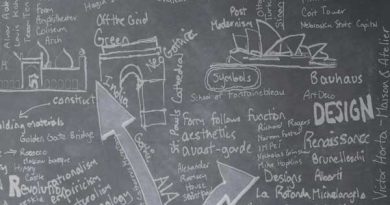Design Thinking Tools: Reverse Brainstorming
Many tools and techniques involve the design thinking process such as mind maps, brain dumps, group discussion, SWOT analysis, reversed brainstorming and others. Each of these tools has its own strong points that qualify it to reach innovative solutions or initiative new project ideas. Previously, we covered the six hats of critical thinking for De Bono and the Lego Serious Play as a tool for creative thinking inside organizations.
One of the powerful tools and most commonly known and used is brainstorming. In simple ways, it refers to holding a group meeting with the stakeholders to combine ideas and discuss the problem and the challenges that they may face solving it. Brainstorming was first introduced by Alex Faickney Osborn in 1939 as a solution to help employees to develop creative ideas in the advertising industry. The brainstorming process depends on focusing on quantity in order to produce quality, withhold criticism and present unusual ideas. Based on these characteristics, the ideas are combined and improved to reach one single most applicable idea.
However, the human brain does not think in this way. Employees cannot just be creative based on a scheduled meeting or by getting the order to become creative. Most creative ideas come to us while taking a shower, brushing our teeth or while driving our cars. Asking someone in a meeting on “how to solve specific problem?” does not help getting creative results.
What is the Reverse Brainstorming?
In order to reach creative output, the process itself needs to be creative and innovative. However, the above-mentioned brainstorming process lacks the creativity that can help to obtain the desired results out of the meeting session. Reverse brainstorming tries to solve the problem in a reversed way to the flow we already now. The method can influence the human mind to create better ideas and solutions.

Instead of asking how to solve the problem, reverse brainstorming focuses on the idea of what causes the problem or how to achieve an opposite result of what is expected. This method helps the team to understand the problem and highlight the ideas that can be used to solve it among other ideas discussed during the meeting. For example, the team thinks how to increase the cost instead of how to reduce it…etc.
The objectives or applying the revered brainstorming
Reverse brainstorming provides unusual thinking methods to reach solutions that ordinary thinking methods do not achieve. As creative thinking requires a special flow of ideas, reverse brainstorming can help teams to create using unique thinking methods. Reverse brainstorming can be applied directly during the discussion meeting or it can be used if ordinary brainstorming fails to reach the desired solution for the problem or the targeted creative approach.
What are the steps of the reverse brainstorming?
Reverse brainstorming session works in a way to achieve the target through five main steps. The team goes through each step and discusses it as a group. These steps include the following:

Step 1: Clearly identify the problem that needs to be solved by the end of the group meeting
Step 2: Reverse the expected process. For example ask the stakeholders questions such as “how can we make the problem worse?” instead of “How can we solve it?”
Step 3: Collect all the reversed solutions. All the ideas are acceptable without no criticism
Step 4: After reaching the cases that make the problem worse, flip these cases to reach the best fixes for the problem.
Step 5: Judge and evaluates the results to reach one best solution.
The above steps start and end in a similar matter to the ordinary brainstorming process. However, the inner steps are reversed to reach the best solution through understanding the worse cases. These steps are discussed during the stakeholder meeting using simple tools such as a whiteboard, erasable markers with different colors and sticky notes.
An Example for applying the reversed brainstorming
One of the practice examples of applying reversed brainstorming could be a design company that is working on improving the website design for a specific client. The problem. Is that website visitors do not stay in the website for enough time or interact with the website content as expected. Based on this scenario, the reversed brainstorming session flows as follows:
The first step is to identify the problem needed to be solved. The website users do not engage or interact with the website content as expected.
In the second step, the team flips the problem. For example. The team asks a question about how to drive the users away from the website and reduce the interaction level.

In the third step, the team thinks of the methods that can drive the user away from the website rather than visiting and interacting with it. For example, the team manager asked the designers to think in methods to drive the user away from the website. The answers can be as following:
- Build complex navigation so users cannot find desired content
- Choose a disturbing color theme and hard to read fonts
- Host the website on a slow server
- Use large files that are hard to load
After building an Idea about the methods that can drive the user away from the website, the fourth step reverses all these methods to reach the possible solutions for the problem such as:
- Build an easy navigation and clear website structure
- Choose comfortable color theme and easy to read fonts
- Choose a reliable hosting service that ensures speed website loading
- Optimize the website content so users can view it properly
The fifth step determine which of these methods are not applicable to the website and how to apply the needed methods in order to solve the user interaction problem.
Conclusion
The reversed brainstorming technique is one of the tools that empower companies and organizations to solve problems through a creative approach. Identifying the problem and how the problem can be worsened can actually help the team to understand the best solution.
The reversed brainstorming technique can also be applied to design and creative education. It helps students to be able to think more creatively through exploring new thinking methods.
Resources
Straker, D. (2012) Reverse Brainstorming. [Accessed: 5th March 2015]
Wilson, C. (2011) Method 4 of 100: Reverse Brainstorming, in 100 User Experience (UX) Design and Evaluation Methods for Your Toolkit. [Accessed: 5th March 2015]
Mindtools. Reverse Brainstorming, A different approach to brainstorming. [Accessed: 5th March 2015]
Mind tools. Assortment of brainstorming techniques. [Accessed: 5th March 2015]
[/ms-protect-content]







This seemed like a spello – did you mean to say ‘unusual’
See pic:
https://imgur.com/a/tSDhkmo
Thanks for the note. Corrected 😉
Should this be ‘Reversed’ ?
See pic:
https://imgur.com/a/5FWveW8
Thanks for your comment. The literature used the verb reverse. I think because it is an action verb to describe the action that the method dictates.